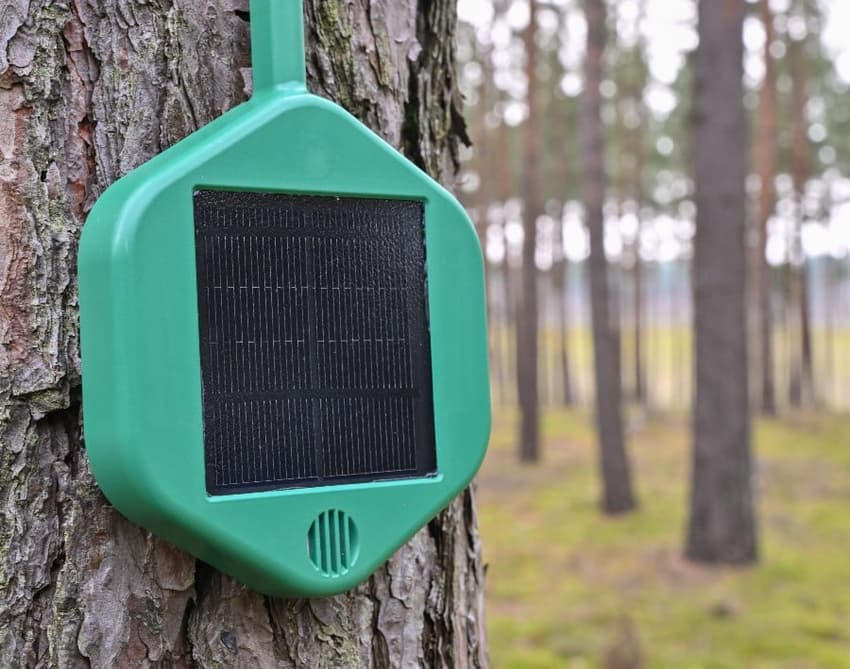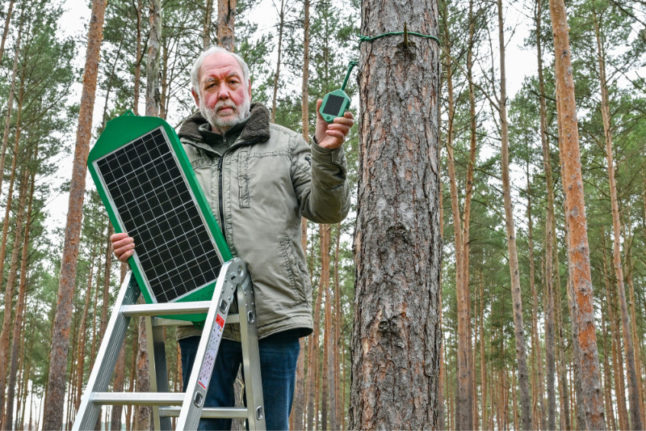How electronic 'noses' help detect forest fires in Germany

Sensors that can sniff out a
wildfire minutes after it starts are being trialled in Brandenburg, the German region most hit by forest fires.
In the heart of Eberswalde forest northeast of Berlin, Jürgen Müller coaxed flames out of a fire pit using highly flammable pine branches as kindling.
It doesn't take long before the first wisps of smoke start curling into the air.
The 69-year-old retired forestry expert has come to test a green-and-black device, powered by solar energy, that can detect the gases emitted during the earliest, smouldering phase of a fire.
The devices were created two years ago by the Berlin start-up Dryad Networks, which Müller co-founded, and come equipped with ultra-sensitive gas sensors developed by German engineering firm Bosch.
READ ALSO: How high is Germany's risk of forest fires right now?
Acting like "an electronic nose", Müller said, the sensors are attached to trees and also monitor temperature, humidity and air pressure.
"In 10, 15 minutes we can detect an incipient fire before it becomes an open fire," he said -- faster than traditional surveillance systems.
400 sensors
With the help of artificial intelligence, the sensor can tell the difference between a nascent wildfire or, for example, the fumes from a passing diesel truck.
At his lab in Eberswalde, Müller also teaches the device to distinguish between different types of wildfires, by exposing it to the smoke from a range of wood shavings.
By doing this, the sensor learns "what the smoke from a pine or beech forest smells like," he said.
As soon as a fire is detected, the data gets relayed to a cloud-based monitoring system and fire authorities are alerted.
Eberswalde forest has been fitted with around 400 sensors, or one device per hectare (2.5 acres), as part of a pilot project with the municipality to test the early-warning system's reliability.
Dryad Networks said 10 countries including the United States, Greece and Spain are already experimenting with the device.
The company sold around 10,000 of the devices last year. By 2030, it aims to have 120 million installed worldwide.

Müller displaying one of his devices in the Eberswalde forest in February 2023. Photo: picture alliance/dpa | Patrick Pleul
Preventing disaster
Raimund Engel, Brandenburg's forest fire protection officer, sees the sensors as a useful addition to the visual detection method currently used in the state.
From the top of 105 towers, 360-degree rotating cameras scan the surrounding landscape where once human observers kept watch.
At the forest fire centre in Wünsdorf, south of Berlin, Engel closely monitors the images they transmit, and sounds the alarm if he spots danger.
With 521 forest fires recorded in 2022, Brandenburg is Germany's worst affected region.
"Because of climate change" the weather conditions in the forest-rich area are "very similar to some Mediterranean regions", Engel said, "with periods of drought and temperatures that sometimes reach up to 40 degrees Celsius."
Super-early intervention is key to preventing wildfires from raging out of control, he said.
"The faster we detect the fire, the quicker firefighters can be on the scene."
READ ALSO: Germany's biggest forest fire of the year continues to spread near Berlin
Comments
See Also
In the heart of Eberswalde forest northeast of Berlin, Jürgen Müller coaxed flames out of a fire pit using highly flammable pine branches as kindling.
It doesn't take long before the first wisps of smoke start curling into the air.
The 69-year-old retired forestry expert has come to test a green-and-black device, powered by solar energy, that can detect the gases emitted during the earliest, smouldering phase of a fire.
The devices were created two years ago by the Berlin start-up Dryad Networks, which Müller co-founded, and come equipped with ultra-sensitive gas sensors developed by German engineering firm Bosch.
READ ALSO: How high is Germany's risk of forest fires right now?
Acting like "an electronic nose", Müller said, the sensors are attached to trees and also monitor temperature, humidity and air pressure.
"In 10, 15 minutes we can detect an incipient fire before it becomes an open fire," he said -- faster than traditional surveillance systems.
400 sensors
With the help of artificial intelligence, the sensor can tell the difference between a nascent wildfire or, for example, the fumes from a passing diesel truck.
At his lab in Eberswalde, Müller also teaches the device to distinguish between different types of wildfires, by exposing it to the smoke from a range of wood shavings.
By doing this, the sensor learns "what the smoke from a pine or beech forest smells like," he said.
As soon as a fire is detected, the data gets relayed to a cloud-based monitoring system and fire authorities are alerted.
Eberswalde forest has been fitted with around 400 sensors, or one device per hectare (2.5 acres), as part of a pilot project with the municipality to test the early-warning system's reliability.
Dryad Networks said 10 countries including the United States, Greece and Spain are already experimenting with the device.
The company sold around 10,000 of the devices last year. By 2030, it aims to have 120 million installed worldwide.

Preventing disaster
Raimund Engel, Brandenburg's forest fire protection officer, sees the sensors as a useful addition to the visual detection method currently used in the state.
From the top of 105 towers, 360-degree rotating cameras scan the surrounding landscape where once human observers kept watch.
At the forest fire centre in Wünsdorf, south of Berlin, Engel closely monitors the images they transmit, and sounds the alarm if he spots danger.
With 521 forest fires recorded in 2022, Brandenburg is Germany's worst affected region.
"Because of climate change" the weather conditions in the forest-rich area are "very similar to some Mediterranean regions", Engel said, "with periods of drought and temperatures that sometimes reach up to 40 degrees Celsius."
Super-early intervention is key to preventing wildfires from raging out of control, he said.
"The faster we detect the fire, the quicker firefighters can be on the scene."
READ ALSO: Germany's biggest forest fire of the year continues to spread near Berlin
Join the conversation in our comments section below. Share your own views and experience and if you have a question or suggestion for our journalists then email us at [email protected].
Please keep comments civil, constructive and on topic – and make sure to read our terms of use before getting involved.
Please log in here to leave a comment.